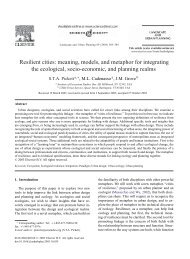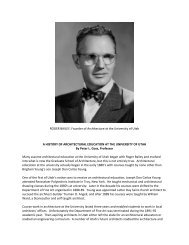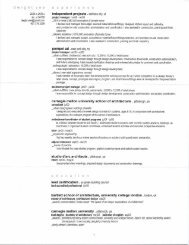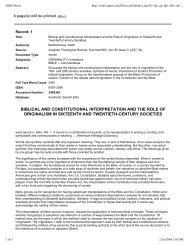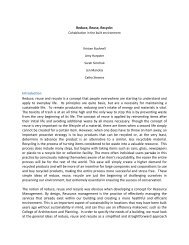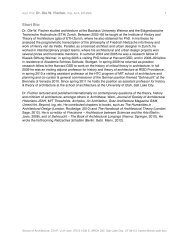Long-term trends and a sustainability transition
Long-term trends and a sustainability transition
Long-term trends and a sustainability transition
You also want an ePaper? Increase the reach of your titles
YUMPU automatically turns print PDFs into web optimized ePapers that Google loves.
materials consumption is growing rapidly with little or no sign ofslowing. And for the poorest people <strong>and</strong> least developed countries,consumption is grossly inadequate, with unmet needs for energy<strong>and</strong> materials for food production, housing, consumer goods,transportation, <strong>and</strong> health.Changing Products <strong>and</strong> Technologies. The mix of products <strong>and</strong> thetechnologies that produce them is changing. Services have grownfrom 50% of global gross national product in 1972 to 63% in 1999(32), as has the production of information- or knowledge-richproducts. Consuming such products <strong>and</strong> services absorbs affluencebut reduces the amount of energy <strong>and</strong> materials consumed. Economichistory finds that industrialized countries regularly replacetheir lead technologies (33). The emerging technologies of the latest<strong>transition</strong> include energy sources <strong>and</strong> transmission, new materials,<strong>and</strong> the substitution of information for energy <strong>and</strong> materials,technologies that continue long-<strong>term</strong> processes of decarbonization,dematerialization, <strong>and</strong> detoxification.It is possible to accelerate these long-<strong>term</strong> processes. To reducethe level of harm per unit of consumption, we can separate moredamaging consumption from more benign forms <strong>and</strong> less damaging<strong>and</strong> depleting energy <strong>and</strong> materials for more damaging ones.Beyond substitution, shrinking the energy <strong>and</strong> material transformationsrequired per unit of consumption is most effective. Addressingthe dem<strong>and</strong> side of consumption, it is possible to reduceour consumption by satiation for some goods in high-incomecountries. An emergent research field (34, 35) <strong>and</strong> a small butgrowing ‘‘simplicity’’ movement (36, 37) grapple with how toencourage consumer behavior that will lead to change in consumption.In rich <strong>and</strong> poor countries alike, making <strong>and</strong> selling things toeach other, including things we might not need, is the essence of oureconomic system. Thus, given current <strong>trends</strong>, it seems quite difficultto move from relatively easy efforts to change technology bysubstitution <strong>and</strong> efficiency to changing the making, selling, <strong>and</strong>desiring of things.Globalization, Governance, <strong>and</strong> InstitutionsThe very notion of a <strong>sustainability</strong> <strong>transition</strong>, with its concern forhumankind <strong>and</strong> the planet, reflects a process of globalization orinterconnectedness, emerging forms of governance, <strong>and</strong> changinginstitutions <strong>and</strong> values. Most of these <strong>trends</strong> will work toward a<strong>sustainability</strong> <strong>transition</strong>, but not everywhere. Favorable shifts ininvestment, income, <strong>and</strong> job opportunities in some parts of theinterconnected world are accompanied by the loss of jobs elsewhere,unpredictable withdrawals of capital, <strong>and</strong> a deepeningdivide in needed skills <strong>and</strong> innovation, all adding new sources ofinstability for the world’s poor.Themajor<strong>trends</strong>areasfollows.Deepening Interconnectedness <strong>and</strong> Persistent Diversity. ‘‘In its simplestsense, globalization refers to the widening, deepening, <strong>and</strong>speeding up of global interconnectedness’’ (38). Economic production<strong>and</strong> consumption, migration, communication, <strong>and</strong> technologyall reflect this greater interconnectedness (1). Since 1950, trade hasgrown at more than twice the rate of economic growth, <strong>and</strong> currenttrade in money <strong>and</strong> capital is 100 times greater than trade in goods<strong>and</strong> services. Words, images, <strong>and</strong> ideas outpace the flow of products.The flow of people has also increased <strong>and</strong> with it thepersistence of diversity, particularly in urban areas that attractmigrants. This interconnectedness also makes possible the rapidtransmission of infectious diseases <strong>and</strong> invasions of biota. Environmentalharms are exported to countries with weaker environmentalst<strong>and</strong>ards. Concerns about the environment spread, as do increasesin consumption fueled by marketing <strong>and</strong> rapid cultural change.There are also strong countercurrents to global culture that emphasizeethnic, national, <strong>and</strong> religious distinctiveness, never moreevident than on September 11, 2001, when, in the name of religion,the symbolic elements of a globalized economy <strong>and</strong> military powerwere targeted.Widening Governance. Connectedness <strong>and</strong> diversity are also reflectedininstitutionalinnovation<strong>and</strong>powershifts.Atagloballevel,new institutions of governance have emerged, transnational corporate<strong>and</strong> financial institutions grow <strong>and</strong> consolidate, <strong>and</strong> networksof nongovernmental institutions collaborate <strong>and</strong> exp<strong>and</strong>. At thesubnational level, government has devolved, privatization is common,<strong>and</strong> civic society in many places has been strengthened. Powerhas shifted from the national state upward to the global level <strong>and</strong>downward to the local level, <strong>and</strong> at all levels from the publicto the private (39, 40). Again, the events of September 11, 2001,illustrate how great military power could shift to a shadowynongovernmental organization.Changing Values. The last 50 years have also seen extraordinarychanges in values, attitudes, <strong>and</strong> actual behavior. The World ValuesSurveys have marked a generational <strong>transition</strong> from ‘‘traditional’’ to‘‘modern’’ <strong>and</strong> most recently ‘‘postmodern’’ values that include thevalues underlying the great attitudinal <strong>and</strong> behavioral shifts in sex<strong>and</strong> reproduction, the role of women, the environment, <strong>and</strong> humanrights. Economic development tends to push societies in thiscommon direction, but societal values, rather than converging,seem to move on parallel tracks distinctly shaped by their culturalheritages (41).In general, there seems to be little opportunity to change themajor directions in <strong>trends</strong> of globalization of increasing interconnectedness,persistent diversity, <strong>and</strong> shifts in power betweenpublic <strong>and</strong> private, local <strong>and</strong> global. Indeed, the very notion of‘‘sustainable development’’ is a product of the interconnectednessthat characterizes globalization. But if the goods of globalization areto be realized <strong>and</strong> its ills are to be reduced for those people <strong>and</strong>natural systems most vulnerable, then globalization itself mustchange in some significant way. In similar historic periods ofnational <strong>and</strong> continental transformation, needed changes emergedthat suggest parallels for today. Early regulatory effort was neededaround what today are called ‘‘rule of law’’ <strong>and</strong> ‘‘transparency’’issues, such as those that make contracts enforceable or stockcertificates verifiable. These efforts were followed by various attemptsto control monopoly power <strong>and</strong> maintain genuine competitiveness.Much slower were those efforts that recognized thevictims, harms, inequities, <strong>and</strong> externalities generated by the newintegrated industrial system. Last were efforts to reduce environmentalharm. The challenge for humanizing globalization is toreduce the duration of this century-long precedent by half, thuscontrolling the extremes of economic power, assisting victims ofchange, <strong>and</strong> protecting the environment in no more than twogenerations (42).Global Environmental ChangePreserving the life support systems of the planet is made moredifficult by the rapid <strong>and</strong> continuing global environmental changesin the air, oceans, l<strong>and</strong>, <strong>and</strong> freshwater systems. Because most ofthese are linked to human actions, including actions to meet humanneeds, slowing, stabilizing, or reversing such change takes on greaturgency for a <strong>sustainability</strong> <strong>transition</strong>.Rapid Environmental Change <strong>and</strong> Changing Problems. Local, regional,<strong>and</strong> global environmental change by humans has beenunderway for at least the past 10,000 years, but most of that changehas occurred over the last half-century (43). The atmosphere <strong>and</strong>oceans, l<strong>and</strong> <strong>and</strong> freshwaters, species, ecosystems, <strong>and</strong> living resources,<strong>and</strong> the great biogeochemical <strong>and</strong> hydrological cycles havebeen fundamentally altered. Flows of materials <strong>and</strong> energy that areremoved from their natural settings or synthesized now rival theflows of such materials within nature itself. Overall estimates of thehuman modification, management, or appropriation of naturerange up to one-half of the terrestrial ecosystems (44) <strong>and</strong> onequarterof the freshwater supply (45).For humankind, the dominant environmental problems related8064 www.pnas.orgcgidoi10.1073pnas.1231331100 Kates <strong>and</strong> Parris
periurban, recreational, <strong>and</strong> preservation–conservation uses <strong>and</strong>through more rapid growth from increased carbon dioxide <strong>and</strong>global warming (71–82). But one major exception relates to theformer comm<strong>and</strong> economies, particularly Siberia, where deforestationis significant <strong>and</strong> occurring at high rates (72, 73).Intensification <strong>and</strong> expansion in cultivated l<strong>and</strong>s. Averylong-<strong>term</strong>trend finds intensified production on prime cropl<strong>and</strong>s in industrialized<strong>and</strong> industrializing economies predicated on high inputsof water, fertilizer, pesticides, <strong>and</strong> improved seeds, althoughlimits to yield increases are now becoming apparent. Lessdeveloped economies tend to have both high-input (often irrigated)systems <strong>and</strong> lower-input systems with increasing competitionbetween commercial production <strong>and</strong> the subsistence agricultureessential to household needs, especially in subSaharanAfrica (74, 75). Thus sustained expansion of cropl<strong>and</strong>s will takeplace in developing economies, especially the tropics, arid <strong>and</strong>semiarid l<strong>and</strong>s, <strong>and</strong> high mountains (43). These l<strong>and</strong>s situated inthe tropics are precisely those most susceptible to climatewarming (76), <strong>and</strong> those also arid may suffer from significantwater shortages (43).Modification of grassl<strong>and</strong>s <strong>and</strong> pasturel<strong>and</strong>s. Trends for grassl<strong>and</strong>s <strong>and</strong>pasturel<strong>and</strong>s are poorly understood <strong>and</strong> are caught up in the‘‘desertification’’ theme that has overestimated human degradationof arid l<strong>and</strong>s globally <strong>and</strong> in specific cases, such as the expansion ofthe Sahara (77, 78). ‘‘Systematic’’ assessments providing estimatesof grassl<strong>and</strong> change have too large a variance to be helpful (79), butagreement exists that grassl<strong>and</strong>s have been extensively modifiedworldwide, perhaps increasingly degraded in <strong>term</strong>s of st<strong>and</strong>ingbiomass (80, 81). Pasturel<strong>and</strong>s will continue to exp<strong>and</strong> in LatinAmerica, although much of the areas transformed to pasture willrevert back to other l<strong>and</strong> covers. Small areas of ab<strong>and</strong>oned cultivationhave reverted to grassl<strong>and</strong>s in the southern Great Plains ofthe U.S. (82).Decreasing biological diversity <strong>and</strong> increasing biological invasions. Directlyrelated to the rapid l<strong>and</strong> changes is the decreasing diversitythrough either species extinction or species reduction in managedagroforestry systems. Recent extinction rates are 100–1,000 theirprehuman levels (83). At present, 11% of bird species, close to 18%of mammals, 8% of plant species, <strong>and</strong> 5% of fish species arecurrently threatened (44, 84). In areas where studies have beencarried out, 20% of freshwater species are threatened, endangered,or extinct (62). Overfishing, dam building, irrigation, <strong>and</strong>urban, agricultural, <strong>and</strong> industrial contamination have turned greatlakes into wastel<strong>and</strong>s. In a globalized world, biological invasionshave grown. Exotic species have increased diversity in some places<strong>and</strong> decreased it elsewhere as immigrant species replace localones (85).Absent unlikely changes in the global political economy, the l<strong>and</strong><strong>trends</strong> noted here appear hard to abate in the near future, if onlybecause so many of the changes underway take place in conditionsin which the human agents of change have few choices. One currenttrend that should continue is agricultural intensification on primel<strong>and</strong>s to allow marginal l<strong>and</strong>s to revert back to tree or grass cover.Favorably influencing the long-<strong>term</strong> <strong>trends</strong> of declining biodiversitywill require new approaches to l<strong>and</strong> management. Past practices ofpreserving specific species or l<strong>and</strong> areas will have to be augmentedto address ecosystems as a whole, including their human inhabitants.These efforts may include the creation of corridors thatconnect pieces of fragmented habitats, creating low-impact livelihoodsfor residents <strong>and</strong> establishing dem<strong>and</strong> for lesser-impactcrops. Prevention is the best approach toward the control of invasivespecies. However, this task has become much more difficult in theface of rapidly growing global commerce <strong>and</strong> travel.Freshwater. Freshwater is one of the fundamental building blocks oflife. Continued access to freshwater is required for drinking water,agricultural production, <strong>and</strong> industrial processes.Growing but slowing water withdrawals. ‘‘Global withdrawals of waterto satisfy dem<strong>and</strong>s have grown dramatically in this century. Between1900 <strong>and</strong> 1995, water withdrawals increased by over six times,more than double the rate of population growth. This rapid growthin water dem<strong>and</strong> is due to the increasing reliance on irrigation toachieve food security, the growth of industrial uses, <strong>and</strong> theincreasing use per capita for domestic purposes’’ (86). However, percapita withdrawals peaked in the mid-1980s. Since then, per capitawater withdrawals have declined <strong>and</strong> absolute water withdrawalshave slowed worldwide (87). In industrialized countries, competingneeds for urban, industrial, <strong>and</strong> agricultural use have encouragedgreater efficiency of use, leading to reduced per capita consumption.In the U.S., for example, per capita water withdrawal declinedby 22% between 1980 (its peak) <strong>and</strong> 1995 (88).Growing regional <strong>and</strong> local scarcity. Although freshwater is widelyavailable, it is unevenly distributed. Many places in the world sufferlocal shortages, <strong>and</strong> water stress is widespread in one-third of theworld, where withdrawals exceed 20% of available supply (86). Inmany places, the quality of available water continues to declinebecause of pollution <strong>and</strong> salinization. Most significant is the unmetneed for household water use, with 1.2 billion people in developingcountries lacking access to a safe <strong>and</strong> reliable supply <strong>and</strong> 2 billionlacking access to sanitation.Agriculture, primarily irrigation, accounts for 70% of currentfreshwater withdrawals (86). This suggests that the largest opportunityfor accelerating the trend in reducing freshwater withdrawalsis through greater efficiency in agricultural production. For industrializingcountries in arid regions, there are major opportunities toreduce industrial <strong>and</strong> residential consumption by reducing losses<strong>and</strong> improving technology (86).ConclusionDespite United Nations Secretary-General Kofi Annan’s words,‘‘[t]he summit makes sustainable development a reality,’’ the recentlyconcluded World Summit for Sustainable Developmentmade at best modest contributions to a <strong>sustainability</strong> <strong>transition</strong>.There should be little doubt that such a 2050 <strong>transition</strong> that met theneeds of a much larger population while preserving the planet’slifesupport systems is possible (1, 5). Nonetheless, a global <strong>transition</strong>is in doubt because of the long-<strong>term</strong> <strong>trends</strong> described in this article,some of which make a <strong>transition</strong> more likely <strong>and</strong> others that makeit less so. Indeed, each of the major classes of <strong>trends</strong> are comprisedof a collection of multi<strong>trends</strong>, containing in essence both the ‘‘goodnews’’ <strong>and</strong> ‘‘bad news’’ for the future of a <strong>transition</strong>. Many of thedifferences in <strong>trends</strong> are expressed spatially, with different regionsexperiencing the good news or the bad news.In our judgment, if the mix of favorable <strong>and</strong> unfavorable <strong>trends</strong>continues at the current pace, it is unlikely that a 2050 <strong>transition</strong> willbe realized. The current pace of meeting such human needs asfeeding, nurturing, educating, housing, <strong>and</strong> employing the growingpopulation, while improving, is well behind the pace needed torealize such international targets as halving the number of hungryor providing clean water <strong>and</strong> sanitation (20). At the same time, theabsolute growth in threats to the life support systems from theworld’sproduction<strong>and</strong>consumptionsystemsstillexceedsthepaceof the countering <strong>trends</strong> in reducing energy <strong>and</strong> material use, inreducing pollutants, <strong>and</strong> in controlling the unsustainable extractionof l<strong>and</strong> <strong>and</strong> sea resources.Thus a central task of sustainable development will be toaccelerate the <strong>trends</strong> that favor a <strong>transition</strong> <strong>and</strong> slow the <strong>trends</strong> thatimpede them. The <strong>trends</strong> described in this paper can provide achecklist for a continuing assessment of the major forces affectinga<strong>sustainability</strong><strong>transition</strong>.Becausesustainabledevelopmenttakesplace locally rather than globally, an important task for a placebased<strong>sustainability</strong> science is to identify the specific <strong>trends</strong> mostrelevant to such places <strong>and</strong> the ways in which local populations cancontribute to altering the <strong>trends</strong> that affect them (89).8066 www.pnas.orgcgidoi10.1073pnas.1231331100 Kates <strong>and</strong> Parris
It is also characteristic of much current debate to selectivelychoose those <strong>trends</strong> supportive of particular positions <strong>and</strong> ignorecontradictory <strong>trends</strong>. Thus, some analysts choose to emphasizeeither growing populations or slowing population growth, growingenergy <strong>and</strong> material consumption, or declining energy <strong>and</strong> materialuse per unit of value, growing incomes or growing inequality ofincomes; yet all these <strong>trends</strong> are significant. Given the tendency ofparticipants in contentious public dialogues to selectively note onlythe specific <strong>trends</strong> that support their point of view, it is theresponsibility of <strong>sustainability</strong> science to map the broad, inclusive,1. National Research Council (1999) Our Common Journey (Natl. Acad. Press, Washington,DC).2. Raskin, P., Gallopin, G., Gutman, P., Hammond, A. & Stewart, R. (1998) Bending theCurve (Stockholm Environmental Inst., Boston).3. Kates, R. W., Clark, W. C., Corell, R., Hall, J. M., Jaeger, C. C., Lowe, I., McCarthy,J. J., Schellnhuber, H. J., Bolin, B., Dickson, N. M., et al. (2001) Science 292, 641–642.4. Kates, R. W. (2001) Forum on Science <strong>and</strong> Technology for Sustainability (http:<strong>sustainability</strong>science.org).5. Raskin, P., Banuri, T., Gallopín, G., Gutman, P., Kates, R. & Swart, R. (2002) GreatTransition (Stockholm Environmental Inst., Boston).6. Gurr, T. R., Marshall, M. G. & Khosla, D. (2001) Peace <strong>and</strong> Conflict 2001 (Center forInternational Development <strong>and</strong> Conflict Management, College Park, MD).7. Sarkees, M. R. (2000) Conflict Management <strong>and</strong> Peace Science 18, 123–144.8. Drumtra, J. (2001) Refugee Rep. 22, 1–7.9. Kaplan, R. D. (1994) Atlantic Monthly 273, 44–76.10. Huntington, S. P. (1993) Foreign Affairs 72, 22–49.11. Sollenberg, M. & Wallensteen, P. (2001) in SIPRI Yearbook 2001 (Oxford Univ. Press,Oxford).12. Lash, J. (2001) Science 294, 1789.13. Folke, C., Jansson, A., Larsson, J. & Costanza, R. (1997) Ambio 26, 167–172.14. Chameides, W. L., Kasibhatla, P. S., Yienger, J. & Levy, H. (1994) Science 264, 74–77.15. United Nations Population Division (2003) World Population Prospects (United Nations,New York), ESAPWP, 180.16. United Nations Population Division (2002) World Urbanization Prospects the 2001Revision (United Nations, New York).17. Bongaarts, J. & Bruce, J. (2001) in The Unfinished Agenda, eds.Pinstrup-Andersen,P.&P<strong>and</strong>ya-Lorch,R.(Internat.FoodPolicyResearchInst.,Washington,DC).18. Ausubel, J. H. & Herman, R. (1988) Cities <strong>and</strong> Their Vital Systems (Natl. Acad. Press,Washington, DC).19. United Nations Development Programme (2002) Human Development Report 2002(United Nations Development Programme, New York).20. Parris, T. M. & Kates, R. W. (2003) Proc. Natl. Acad. Sci. USA 100, 8068–8073.21. Maddison, A. (2001) The World Economy (Organisation for Economic Cooperation <strong>and</strong>Development, Paris).22. World Bank (2001) Global Economic Prospects <strong>and</strong> the Developing Countries 2001(International Bank for Reconstruction <strong>and</strong> Development, Washington, DC).23. United Nations Development Programme (1996) Human Development Report 1996(Oxford Univ. Press, New York).24. Galbraith J. K. & Berner, M. (2001) Inequality <strong>and</strong> Industrial Change (Cambridge Univ.Press, New York).25. Baumol, W. J., Nelson, R. R. & Wolff, E. N. (1994) Convergence of Productivity (OxfordUniv. Press, New York).26. Sen, A. K. (1982) Poverty <strong>and</strong> Famines (Oxford Univ. Press, New Delhi).27. World Bank (2000) World Development Indicators 2000 (International Bank for Reconstruction<strong>and</strong> Development, Washington, DC).28. World Resources Institute (2000) World Resources 2000–2001 (World Resources Inst.,Washington, DC).29. Barrett, R., Kuzawa, C. W., McDade, T. & Armelagos, G. J. (1998) Annu. Rev.Anthropol. 27, 247–271.30. Stern, P. C., Dietz, T., Ruttan, V., Socolow, R. H. & Sweeney, J. L. (1997) EnvironmentallySignificant Consumption (Natl. Acad. Press, Washington, DC).31. Royal Society of London <strong>and</strong> U.S. National Academy of Sciences (1977) Popul. Dev.Rev. 23, 68386.32. World Bank (2002) World Development Indicators 2002 (International Bank for Reconstruction<strong>and</strong> Development, Washington, DC).33. Grübler, A. & Nowtony, H. (1990) Int. J. Technol. Manage. 5, 431–471.34. Jager, W., van Asselt, M., Rotmans, J., Vlek, C. & Cos<strong>term</strong>an Boodt, P. (1997)Consumer Behavior (Natl. Inst. for Public Health <strong>and</strong> the Environment, Bilthoven, TheNetherl<strong>and</strong>s), Rep. 461502017.35. Vellinga, P., de Bryn, S., Heintz, R. & Mulder, P. (1997) Industrial Transformation (Inst.for Environmental Studies, Amsterdam), IHDP-IT, no. 8.36. Nearing, H. & Nearing, S. (1990) The Good Life (Schocken, New York).37. Elgin, D. (1993) Voluntary Simplicity (William Morrow, New York).38. Held, D. (1999) Global Transformations (Stanford Univ. Press, Stanford, CA).39. Mathews, J. T. (1997) For. Aff. 76, 50–66.40. Clark, W. C. (2001) Ecol. Law Q. 27, 1021–1075.41. Inglehart, R. & Baker, W. E. (2000) Am. Soc. Rev. 65, 19–51.42. Kates, R. W. (2003) in Worlds Apart: Globalization <strong>and</strong> the Environment,ed.Speth,G.J.(Isl<strong>and</strong>, Washington, DC), pp. 85–107.43. Turner, B. L., II, Clark, W. C., Kates, R. W., Richards, J. F., Mathews, J. T. & Meyer,W. B. (1990) The Earth as Transformed by Human Action (Cambridge Univ. Press,Cambridge, U.K.).44. Vitousek, P. M., Mooney, H. A., Lubchenco, J. & Melillo, J. M. (1997) Science 277, 494–499.45. Postel, S. L., Daily, G. C. & Ehrlich, P. M. (1996) Science 271, 785–788.<strong>and</strong> contradictory currents that humankind will need to navigatetoward a just <strong>and</strong> sustainable future.We thank B. L. Turner II <strong>and</strong> Alex Pulsipher for extensive analysis ofl<strong>and</strong> use <strong>and</strong> cover change <strong>and</strong> our other colleagues in the Research <strong>and</strong>Assessment Systems for Sustainability Program (http:sust.harvard.edu) for encouragement <strong>and</strong> constructive criticism of earlier drafts. Thispaper is based on research supported in part by a grant from the NationalScience Foundation (Award BCS-0004236), with contributions from theNational Oceanic <strong>and</strong> Atmospheric Administration’s OfficeofGlobalPrograms for the Research <strong>and</strong> Assessment Systems for SustainabilityProgram, <strong>and</strong> ISciences, LLC.46. World Bank (1992) World Development Report 1992 (International Bank for Reconstruction<strong>and</strong> Development, Washington, DC).47. Lefohn, A. S., Husar, J. D. & Husar, R. (1999) Atmos. Environ. 33, 3435–3444.48. Intergovernmental Panel on Climate Change (2000) Special Report on EmissionScenarios (Cambridge Univ. Press, Cambridge, U.K.).49. Streets, D. G., Tsai, N. Y., Akimoto, H. & Oka, K. (2000) Atmos. Environ. 34, 4413–4424.50. Streets, D. G., Tsai, N. Y., Akimoto, H. & Oka, K. (2001) Water Air Soil Poll. 130, 187–192.51. Klimont, Z., Streets, D. G., Gupta, S., Cofala, J., Fu, L. X. & Ichikawa, Y. (2002) Atmos.Environ. 36, 1309–1322.52. Molina, M. J. & Rowl<strong>and</strong>, F. S. (1974) Nature 249, 810–812.53. Farman, J. C., Murgatroyd, R. J., Silnickas, A. M. & Thrush, B. A. (1985) Q. J. R. Meteor.Soc. 111, 1013–1025.54. Crutzen, P. J. & Arnold, F. (1986) Nature 324, 651–655.55. Anderson, J. G., Brune, W. H. & Proffitt, M. H. (1989) J. Geophys. Res. Atmos. 94,11465–11479.56. Benedick, R. E. (1991) Ozone Diplomacy (Harvard Univ. Press, Cambridge, MA).57. World Meteorological Organization (1998) Scientific Assessment of Ozone Depletion1998 (World Meteorological Organization, Geneva).58. Intergovernmental Panel on Climate Change (2001) Technical Summary: A Report ofWorking Group I of the Intergovernmental Panel on Climate Change (IntergovernmentalPanel on Climate Change, Geneva).59. Energy Information Agency (2002) International Energy Annual 2000 (U.S. Dept. ofEnergy, Washington, DC), Appendix H.60. Jickells, T. D., Carpenter, R. & Liss, P. S. (1990) in The Earth As Transformed by HumanAction, eds.Turner,B.L.,II,Clark,W.C.,Kates,R.W.,Richards,J.F.,Mathews,J.T.&Meyer,W.B.(CambridgeUniv.Press,Cambridge,U.K.).61. Cohen, J. E., Small, C., Mellinger, A., Gallup, J. & Sachs, J. (1997) Science 278, 1209–1213.62. Food <strong>and</strong> Agriculture Organization (2000) The State of World Fisheries <strong>and</strong> Aquaculture(Food <strong>and</strong> Agriculture Organization, Rome).63. Hinrichsen, D. (1997) Bioscience 47, 554–558.64. Turner, B. L., II (2002) in Challenges of a Changing Earth: Proceedings of the GlobalChange Open Science Conference, eds.Steffen,W.,Jäger, J., Carson, D. & Bradshaw,C. (Springer, Heidelberg), pp. 21–26.65. Alroy, J. (2001) Science 292, 1893–1896.66. Imhoff, M. L. (1994) Bioscience 44, 598–598.67. World Resources Institute (1998) World Resources 1998–1999 (Oxford Univ. Press,Oxford).68. Food <strong>and</strong> Agriculture Organization (2001) State of the World’s Forests 2001 (FAO,Rome).69. Moran, E. F., Brondizio, E. S., Tucker, J. M., da Silva-Forsberg, M. C., McCracken, S.&Falesi,I.(2000)For. Ecol. Manage. 139, 93–108.70. Skole, D. & Tucker, C. (1993) Science 44, 314–322.71. Tri-Academy Committee (2001) Growing Populations, Changing L<strong>and</strong>scapes (Natl.Acad. Press, Washington, DC).72. Aksenov, D., Dobrynin, D., Dubinin, M., Egorov, A., Isaev, A., Karpachevskiy, M.,Laestadius, L., Potapov, P., Purekhovskiy, A., Turubanova, S. & Yaroshenko, A. (2002)Atlas of Russia’s Intact Forest L<strong>and</strong>scapes (Russian Nongovernmental OrganizationsForest Club, Moscow).73. Bartalev, S., Achard, F., Erchov, D. & Gond, V. (2000) in Vegetation 2000 ConferenceProceedings, ed.Saint,G.(JointResearchCenter,Ispra,Italy),pp.127–142.74. Ruttan, V. W. (2002) J. Econ. Perspect. 16, 161–184.75. Turner, B. L., II, Hyden, G. & Kates, R. W., eds. (1993) Population Growth <strong>and</strong>Agricultural Change in Africa (Univ. Press of Florida, Gainesville).76. Rosenzweig, C. & Hillel, D. (1998) Climate Change <strong>and</strong> the Global Harvest (Oxford Univ.Press, New York).77. Johnson, D. L. & Lewis, L. A. (1995) L<strong>and</strong> Degradation (Blackwell, Oxford).78. Thomas, D. S. G. (1997) J. Arid Environ. 37, 599–608.79. Klein Goldewijk, K. (2001) Global Biogeochem. Cycles 15, 417–433.80. Behnke, R., Scoones, I. & Kerven, C. (1993) Range Ecology at Disequilibrium (OverseasDevelopment Inst., London).81. Chapman, G. P., ed. (1992) Desertified Grassl<strong>and</strong>s (Academic, London).82. Brooks, E. & Emel, J. (2000) The Llano Estacado of the US Southern High Plains (UnitedNations Univ. Press, Tokyo).83. Pimm, S. L., Russell, G. J., Gittleman, J. L. & Brooks, M. (1995) Science 269, 347–350.84. Chapin, F. S., III (2000) Nature 405, 234–242.85. Mooney, H. A. & Clel<strong>and</strong>, E. E. (2001) Proc. Natl. Acad. Sci. USA 98, 5446–5451.86. Commission on Sustainable Development (1997) Comprehensive Assessment of theFreshwater Resources of the World (United Nations, New York), ECN 1719979.87. Gleick, P. H. (2000) The World’s Water 1998–1999 (Isl<strong>and</strong>, Washington, DC).88. Solley, W. B., Pierce, R. R. & Perlman, H. A. (1998) Estimated Use of Water in the UnitedStates in 1995 (U.S. Geological Survey, Washington, DC), Circular 1200.89. Association of American Geographers Global Change <strong>and</strong> Local Places Research Group(2002) Global Change in Local Places (Cambridge Univ. Press, Cambridge, U.K.).SOCIAL SCIENCES ECOLOGYSPECIAL FEATUREKates <strong>and</strong> Parris PNAS July 8, 2003 vol. 100 no. 14 8067



